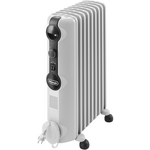
Heating, Cooling & Air Treatment
From climate control to sneeze-free air, tips to feel comfortable and breathe easy at home.
HEATING, COOLING & AIR TREATMENT | 10 SEPTEMBER, 2023
5 MIN READ
5 ways to stay warm and save energy this winter
Stay warm and save energy in winter with our helpful tips.
Looking to save energy and keep your electricity bill from spiralling out of control his winter? Here are some simple ways to stop waste, save energy and lower your energy bill as the mercury drops.

1. Use thermostats on heaters
Set thermostats on heaters to 20°C or lower during the day and 16°C at night to reduce energy use and heat loss. Investing in a smart thermostat can also help you save energy and money by automatically adjusting the temperature based on your preferences and daily routine.
Aim to keep the air temperature comfortable, not hot enough to pad about barefoot, wearing shorts and t-shirt.

2. Use timers on heaters
Heating an empty home, or room, is an easy way to accidentally waste money in terms of home energy use during the winter months. If you manually turn on your heating, whether it’s portable heaters or reverse cycle air conditioning, it’s all too easy to forget to switch it off when you rush out the door. Using a programmable timer to set your heating to come on only when you are at, or approaching, home can do away with this human error!
Keep cosy with electric heaters - Free delivery

3. Use an electric blanket at night
Using an electric blanket is more energy-efficient than leaving the heating on at night because it only heats up a small space - your bed - rather than your entire room or home.
For example, if your electricity costs 30 cents per kilowatt-hour (kWh), and your electric blanket uses 100 watts per hour, it would cost you around three cents per hour to run. If you use a timer or thermostat with the blanket to limit the time its on (because it shouldn't be left on all night) you could be paying just a few cents to stay warm each night.
Go to sleep with a warm hug
Beurer CosyNordic Heated Overblanket Toffee HD75T-NORDIC
Yet to be reviewed
Linen House Plush Electric Heated Throw 01230D425
Yet to be reviewed
Sunbeam Sleep Perfect Anti Bacterial Single Electric Blanket BLA6321
Yet to be reviewed
Sunbeam Sleep Perfect Anti Bacterial King Heated Blanket BLA6371
Yet to be reviewed
Sunbeam Sleep Perfect Quilted Anti Bacterial Single Electric Blanket BLQ6421
Yet to be reviewed
Sunbeam Sleep Perfect Quilted Anti Bacterial King Electric Blanket BLQ6471
Yet to be reviewed

4. Reduce your hot water use
Hot water can account for a significant portion of your energy use during the winter, especially if you have an older, less efficient water heater. To reduce hot water use, wash clothes using the cold water setting on your washing machine.
Difficult though it may be, you might want to also think about taking shorter showers: shower timers and water-saving showerheads can help change your showering habits and reduce your energy consumption in the bathroom.
Investing in an energy efficient water heater, such as a heat pump, continuous flow (tankless) or solar-powered water heater, can also reduce your energy costs during the winter. Heat pump and solar hot water system upgrades may also qualify for Australian government rebates under the Small-scale Renewable Energy Scheme (SRES).
Don't run out of hot water!
Stiebel Eltron DHE18AU 3 Phase Electric Instantaneous Water Heater
Yet to be reviewed
Stiebel Eltron DHE27AU 3 Phase Electric Instantaneous Water Heater
Yet to be reviewed
Stiebel Eltron 220L Heat Pump Hot Water System WWK222
Yet to be reviewed
Aquamax Natural Gas 50-degree Hot Water System G390SS-NG
Yet to be reviewed
Rinnai B26N50A 26L Natural Gas Instantaneous Hot Water System
Yet to be reviewed
Bosch LPG Continuous Flow Hot Water System 7701531975
Yet to be reviewed

5. Reduce heat loss
Insulating the roof, walls or floor of your home can reduce heat loss and help your heating system work more efficiently to maintain a comfortable indoor temperature. If your home is poorly insulated, more heat will escape, which means that your heating system will have to work harder and consume more energy to keep the temperature stable.
Other low-cost ways of reducing heat loss include using draught excluders, ’door snakes’, weatherstrips or door sweeps around the bottom and edges of front and back doors.

Small changes, big difference
By making a few simple changes to the way you use your heating and hot water appliances, and adopting some energy-saving habits, you can keep your winter energy bill in check while taking steps to combat climate change.
If you’re looking to upgrade to energy efficient hot water or heating systems, or reverse cycle air conditioners, Appliances Online has a huge selection to choose from. Check out our Heater Buying Guide for some tips on choosing the best system for you.
Enjoy a warm home sooner with Free, Next Day Delivery*
We deliver heaters, electric blankets, hot water systems and reverse cycle air con units to 95% of Australia’s population with Appliances Online's legendary FREE delivery - and we can usually get it to you by the next day (Mon-Fri).
Check out our full range of home heating systems and if you need a few more tips on choosing the right one for your home, call our friendly team 24/7 on 1300 000 500.

Oli is Appliances Online's editor and blogger, with almost two decades of lifestyle-related writing and editing to his name. With a mission to help you buy better and live smarter, his brand loyalty will forever belong to the appliance manufacturer that develops a self-emptying dishwasher.
Latest Articles
HEATING, COOLING & AIR TREATMENT
14 MAY 2025
Which Sunbeam electric blanket should you get?
Quilted or fleece? Cosy feet zones or antibacterial finish?
KITCHEN
9 MAY 2025
Should you keep eggs in the fridge in Australia?
Different countries have different guidelines. Here’s how we do it in Oz.
HEATING, COOLING & AIR TREATMENT
8 MAY 2025
10 of the best oil column heaters in Australia 2025
Find the best buy to match your room size.
TV, AUDIO & ELECTRONICS
7 MAY 2025
Appliances Online offers FREE connection and setup for TVs
We deliver, unbox and connect new TVs at no extra cost.
More Like This
HEATING, COOLING & AIR TREATMENT
14 MAY 2025
Which Sunbeam electric blanket should you get?
Quilted or fleece? Cosy feet zones or antibacterial finish?
KITCHEN
9 MAY 2025
Should you keep eggs in the fridge in Australia?
Different countries have different guidelines. Here’s how we do it in Oz.
HEATING, COOLING & AIR TREATMENT
8 MAY 2025
10 of the best oil column heaters in Australia 2025
Find the best buy to match your room size.














































































